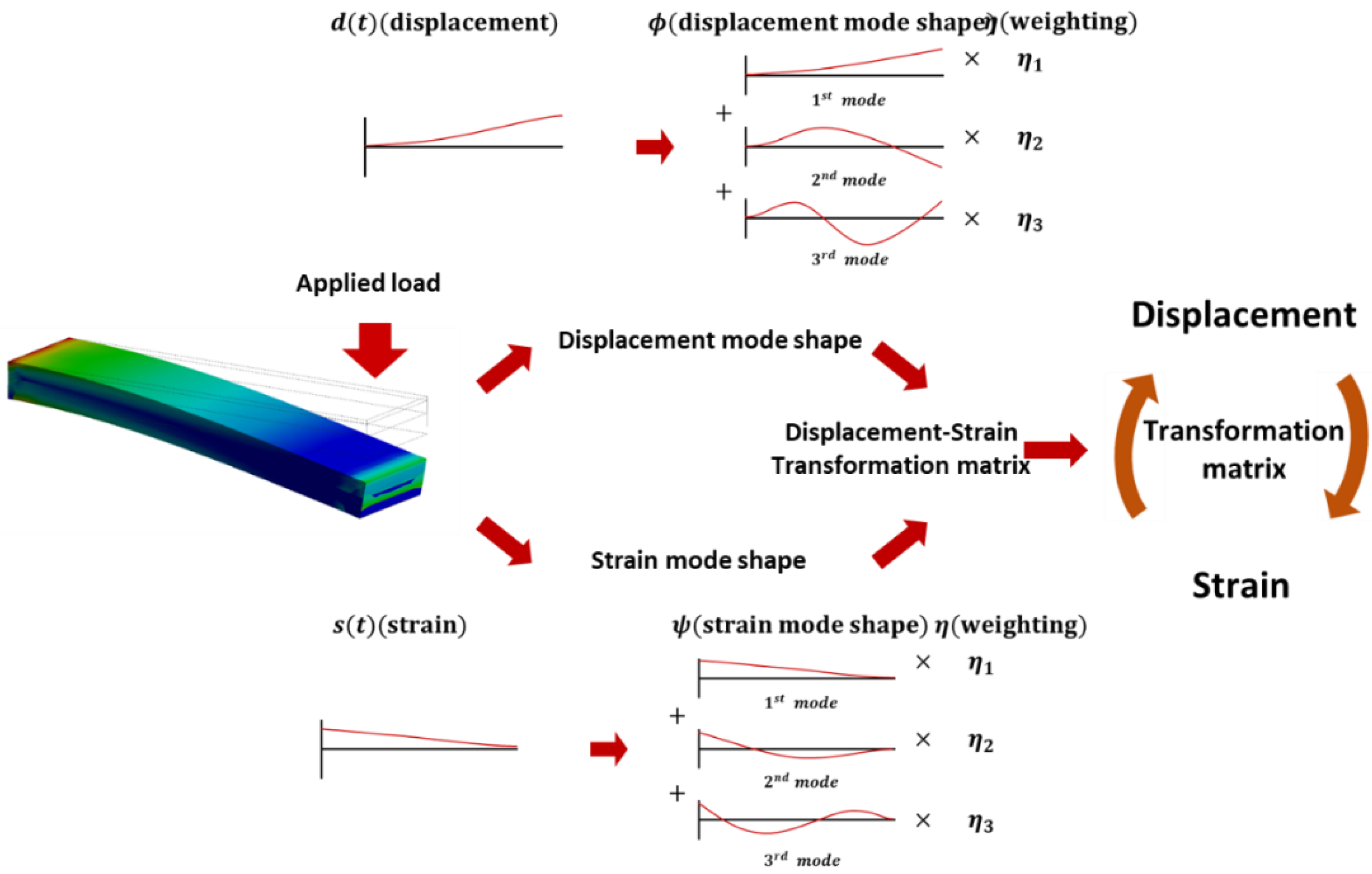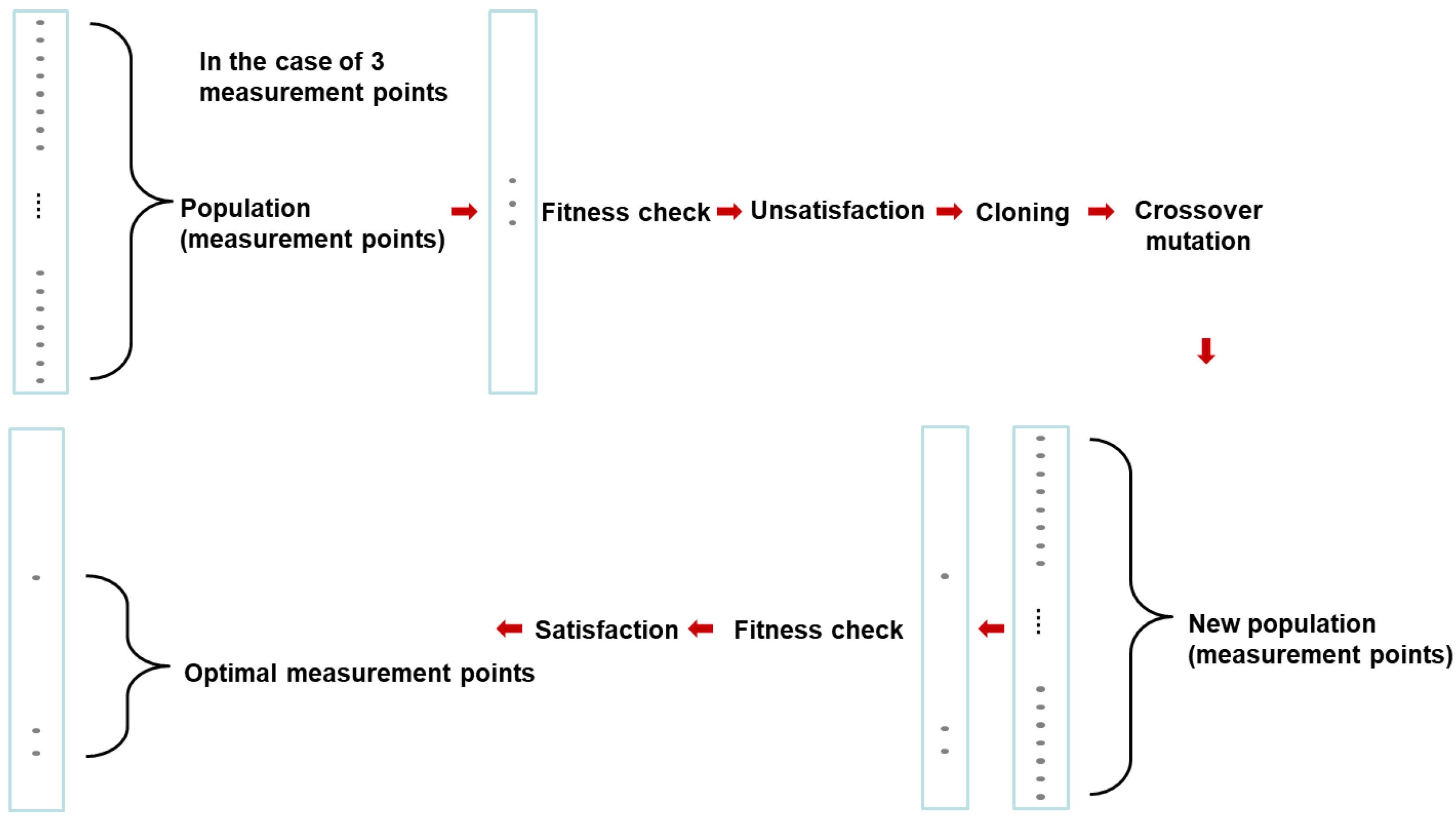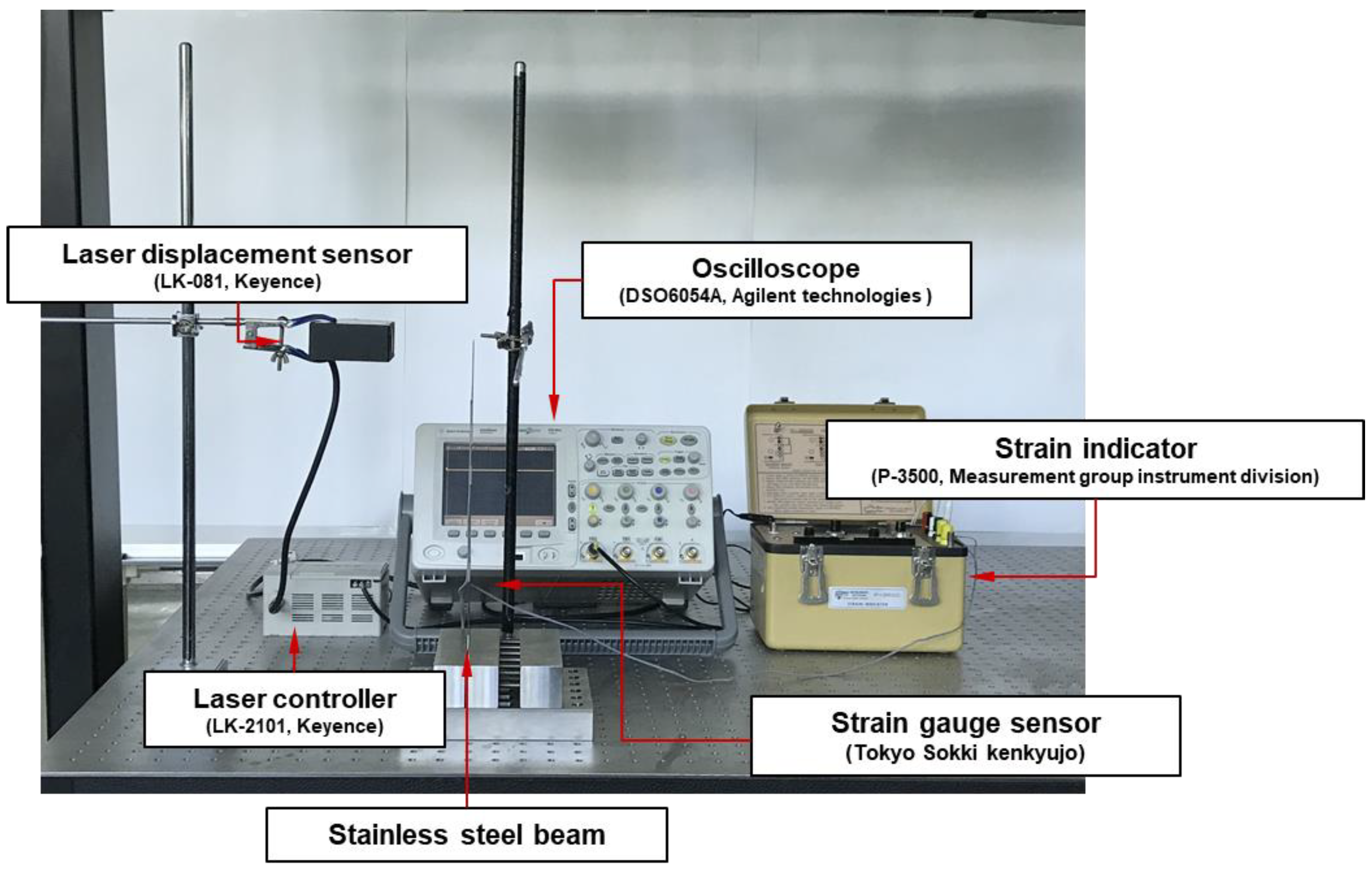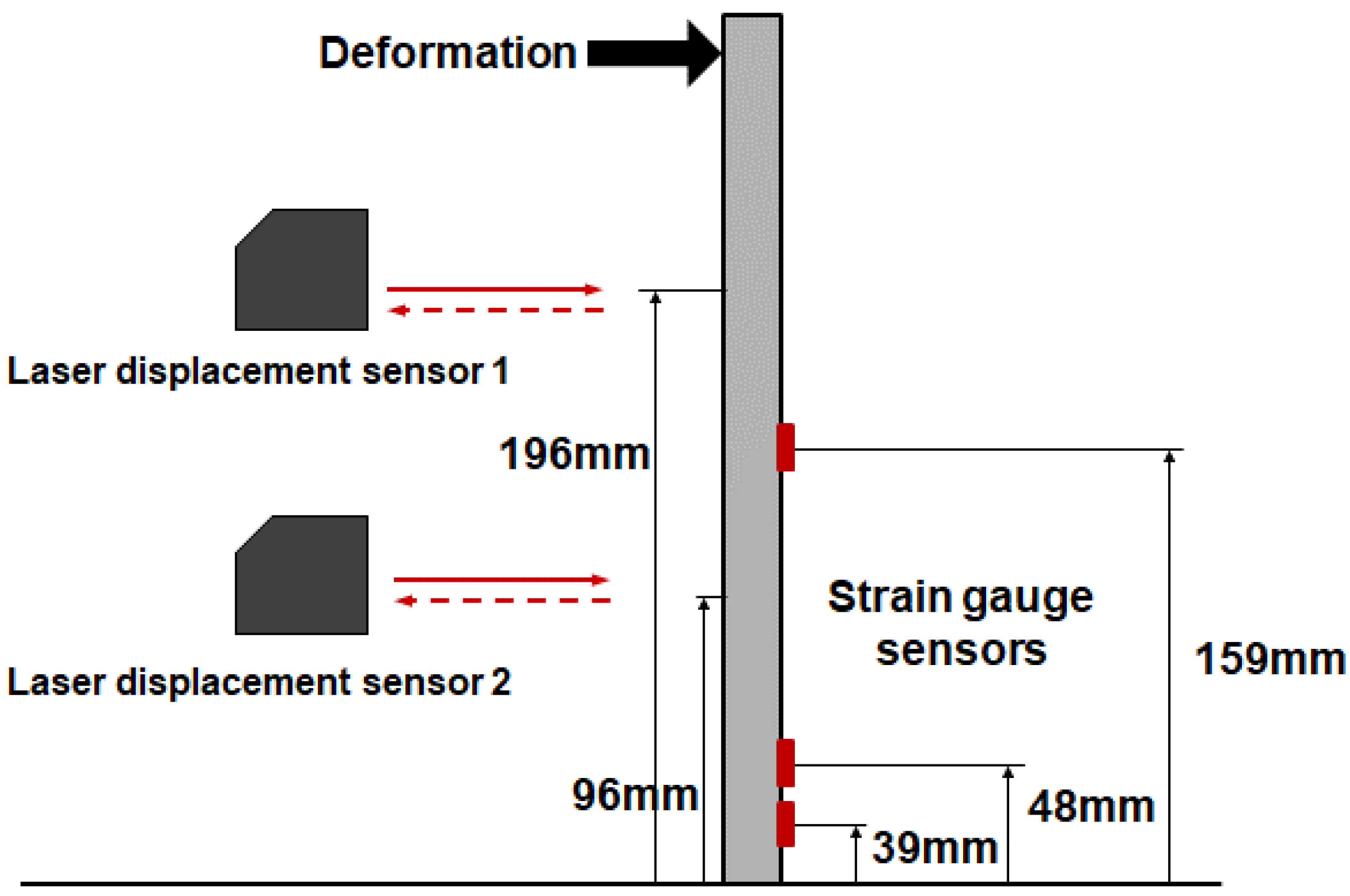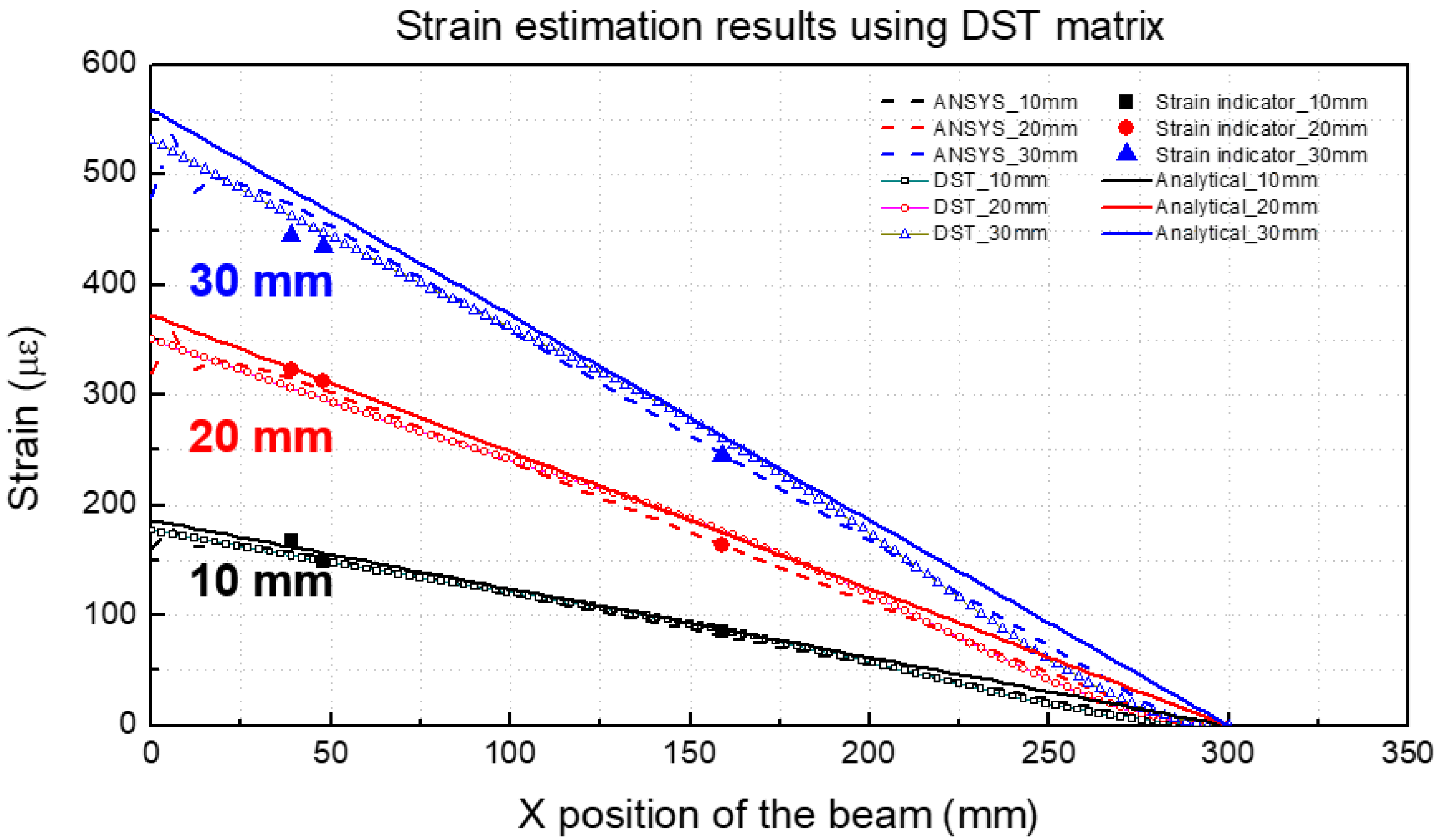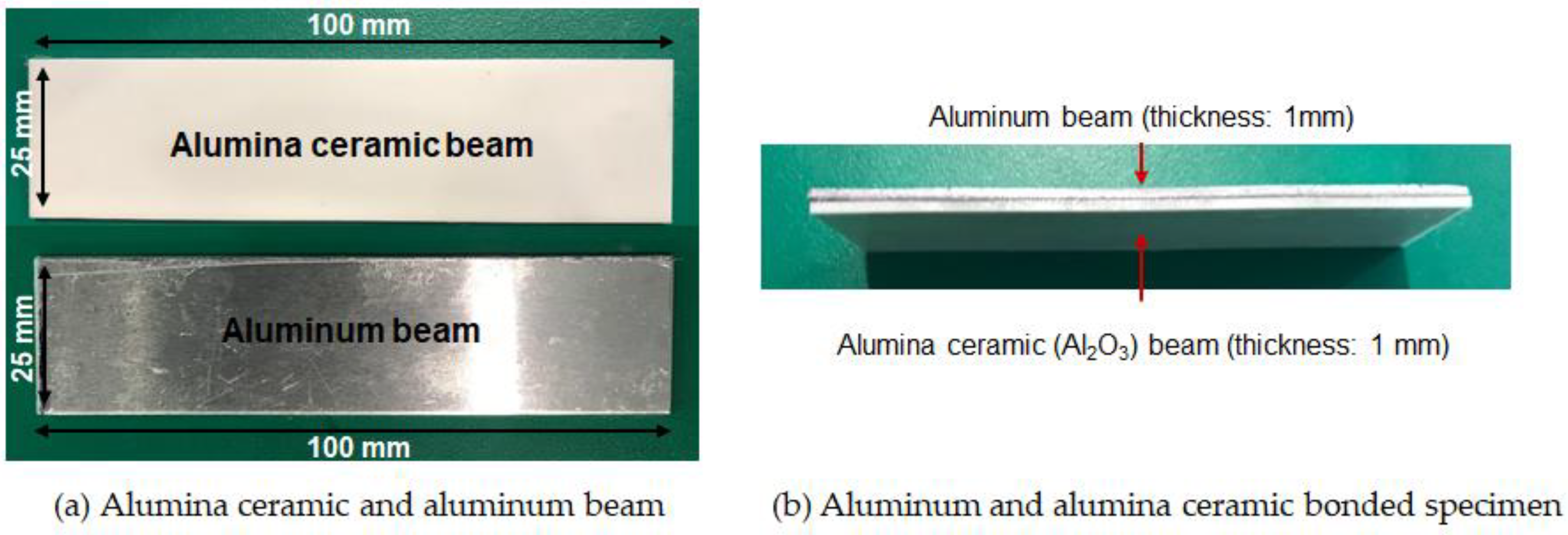1. Introduction
It is necessary to consider maximum deformation, strain, stress and failure of the structure to ensure safe operations. Deformation and strain can be measured using displacement sensors, such as linear variable differential transformers (LVDTs) [
1], potentiometers [
2], laser displacement sensors [
3], strain sensors, such as strain gages [
4] and fiber optic sensors [
5]. Generally, stress and failure can be estimated based on the strain information. However, in some cases, it is not possible to measure the deformation by using displacement sensors. If we imagine an aircraft in operation, it is difficult to apply displacement sensors because displacement sensors should be installed on a fixed frame. In other cases, it is not possible to measure strain by using strain sensors. For example, strain gages cannot be used under very high electromagnetic and thermal environments or severe vibration. Alternatively, it is possible to use strain-based displacement estimation and displacement-based strain estimation methods.
Many studies have focused on structural deformation estimation based on strain information [
6,
7,
8,
9,
10], and these studies are summarized in
Table 1. As shown in
Table 1, strain measurement was performed via strain gages or fiber optic sensors that measure multiple strains along a single strand of the fiber. The maximum estimation error ranges from 1.5%–7%. Researchers used displacement-strain transformation techniques [
6,
7,
10], developed multimetric data fusion techniques [
8] and used a linear classical beam-curvature function with a fiber optic strain sensing algorithm (FOSS) [
9].
However, strain or stress estimation methods using displacement data were not commonly used, because strain sensors can be easily used for many applications, and it is occasionally difficult for displacement sensors to measure actual strains due to slip or failure to measure the reference point. However, if it is not possible to use strain sensors in high temperature conditions in an oven, then displacement data can be alternatively used by laser displacement sensors to estimate the strain or stress of the structure [
11]. It is also possible to apply the image registration [
12] or modal superposition method [
13] for strain estimation.
The proposed displacement or strain estimation method in the study is based on a modal approach. The use of classical beam–curvature functions increases time consumption due to the increase in structural complexity. However, the modal parameter-based approach can reduce the estimation calculation time and be applied in vibration control applications. Furthermore, the proposed method exhibits a significant advantage wherein the complete structural shape or stress information can be calculated by using a small number of sensors.
Figure 1 illustrates the process of estimating the structural deformation or strain by using the displacement–strain transformation matrix.
The authors’ group is continuously developing and improving the displacement–strain transformation method, and the research in our group is summarized in
Figure 2. The displacement–strain transformation method has been actively studied since the early 2000s. At the beginning of the study, deformation predictions for one-dimensional beam shapes [
14] and two-dimensional plates were conducted [
15]. After that, the deformation predictions were obtained by gradually expanding its application range to rotating structures [
16] and actual wind turbine blades [
17].
The present study focuses on multi-material structures such as two-beam bonded structures. This is because many bonded structures are used for certain applications. For example, the application of multi-material structures, such as composite–metal and ceramic–metal combinations, is increasing [
18,
19,
20]. These types of composite structures suffer from problems including delamination and de-bonding. If we apply displacement–strain transformation techniques, then we can obtain the structural deformation and strain information as well as the failure and de-bonding information in a non-destructive manner.
In the study, we first applied the displacement–strain transformation method to a single material structure to verify strain estimation by using displacement data, as well as the deformation estimation by using strain data. Subsequently, a multi-material structure was used in the same verification test. In addition to the simple prediction of deformation or strain, we propose a method that can determine the point of failure and presence of damage by calculating the stress induced in the structure when deformation occurs. The DST method has been widely applied to single materials, but has not been applied to multi-material or brittle materials. In this paper, we wanted to verify the feasibility of deformation prediction by using the DST method to multi-material and brittle structures.
4. Estimation of Deformation and Strain of the Multi-Material Structure
The displacement–strain transformation technique was also applied to a multi-material structure. In the study, the multi-material structure was composed of an aluminum beam, alumina beam and epoxy bonding layer.
Table 5 lists the material properties of each component of the multi-material structure.
The dimensions of the alumina and aluminum beam corresponded to 100 mm in length, 25 mm in width and 1 mm in thickness, as shown in
Figure 10. The thickness of the epoxy layer was measured as 0.15 mm after the bonding of two beams. The epoxy bonding layer was composed of a 2:1 weight ratio of epoxy resin (PRO-SET ADV-175) and hardener (PRO-SET ADV-275) and cured at room temperature for 10 h. The length of the specimen was determined to be shorter than that of the stainless steel beam that was used in single material structure presented in
Section 3 because the cost of the alumina ceramic is very high, and we examined when a rupture of the ceramic occurred during the test. The specimen was fixed using a clamp, and thus, the dimensions of the actual cantilever beam corresponded to 62 mm in length, 25 mm in width, and 2.15 mm in total thickness.
4.1. Sensor Location Optimization
The location of the strain gage sensor was optimized via the genetic algorithm and CN value. Thus, the strain sensor location was determined as 11, 13 and 37 mm, and displacement sensor location was calculated as corresponding to 20, 37 and 56 mm. However, it is not possible to set the positions of the strain gage sensors to the optimized locations due to the difficulty in attaching the strain gage sensor because it was extremely close between the optimized positions. The position of strain gage sensors was determined as 9, 13 and 33 mm for the purpose of convenience. In the case of the laser displacement sensor, the length of the beam was short and installation of the laser displacement sensors was difficult due to the head size. The positions of the laser displacement sensors were set at 22 mm and 52 mm to avoid overlapping of the laser head. Although the position of the sensor was set in a manner different from the optimized position, it could be sufficiently applied to the SDT and DST matrix. Given that the modified sensor position and optimized sensor position were similar to each other, it was not considered to significantly affect the result.
4.2. Experiment Setup for Deformation Estimation of Multi-Material Structure
Figure 11 shows the complete experimental setup for the deformation and strain estimation of the multilayer structure. An end of the specimen was fixed and the other end was deformed in the out-of-plane direction via the linear stage until the specimen was broken. Displacement and strain of the multilayer structure were measured via laser displacement sensors and strain gages, respectively.
4.3. Displacement Estimation Results Using the SDT Method
Figure 12 and
Table 6 show the displacement estimation results using SDT and measured displacements at 22 mm and 52 mm on the alumina side of the beam. The multilayer beam was broken when the deformation of the endpoint of the beam approximately corresponded to 1.2 mm. The estimation error between the experimental value and estimation value using SDT was less than 16.2%.
4.4. Strain Estimation Results Using the DST Method
Figure 13 and
Table 7 present the strains estimated using DST and the strain measured at 9, 13 and 33 mm on the alumina side of the beam. As shown in
Figure 13, the experimental and predicted values for the DST matrix match well with each other.
Table 7 shows the results of the strain estimation, and the error in the DST method is less than 7.6%.
4.5. Stress and Failure Estimation Results Using the DST Method
The stress estimation was conducted via the DST method.
Figure 14 and
Table 8 summarize the result of stress estimation. The multilayer beam was deformed until the beam was broken, and the stress of the multilayer beam was calculated by multiplying the strain and estimated from DST and elastic modulus of the alumina. In the experiment, the multilayer beam was broken when the deformation at the endpoint of the multilayer beam exceeded approximately 1.2 mm. When the deformation of the beam corresponded to 1.2 mm, it was confirmed that the stress applied to the beam is more than 200 MPa. Given that the yield strength of alumina was approximately in the range of 215–248 MPa when the elastic modulus was approximately 330–370 GPa [
25], it was observed that the failure occurred because the stress generated by the deformation applied to the alumina beam exceeded the yield strength of the alumina.
5. Conclusions
In the study, the structural deformation and failure estimation methods using DST and SDT were proposed. We verified the displacement-strain transformation method for the structural deformation and strain estimation of single- and multi-material structures.
First, the DST and SDT methods were applied to a single material structure to verify the strain estimation using displacement data and deformation estimation using strain data. A comparison of the deformation and strain values of the single structure confirmed that the experimental values, predicted values using the DST and SDT matrix and displacement and strain values calculated by the analytical method, agreed well each other.
Second, we verified the multi-material structure. The DST and SDT method was applied to an aluminum–alumina beam. A comparison of the displacement and strain of the multilayer beam indicated that the experimental values and predicted values using the DST and SDT matrix matched well with each other.
Finally, we performed the stress and failure estimation of the multilayer beam. The failure estimation of the multi-material structure was conducted via the DST matrix. The failure prediction results confirmed that the estimated stress using the DST matrix was similar to the stress obtained using the ANSYS simulation. It was also observed that the stress at beam failure was well-matched with the yield strength of the alumina.
It was concluded the displacement–strain transformation method can be used for the deformation and strain estimation of the structure where the displacement or strain sensor cannot be applied. In addition to the simple prediction of the displacement or strain, DST and SDT methods determine the point of failure and presence of damage by calculating the stress of the structure when deformation occurs. The proposed method uses a smaller number of discrete alternative sensors to estimate complete structural deformation, strain and stress distribution. Therefore, it can be used for real-time structural behavior monitoring or control without the need for intensive calculations and numerous sensors.
